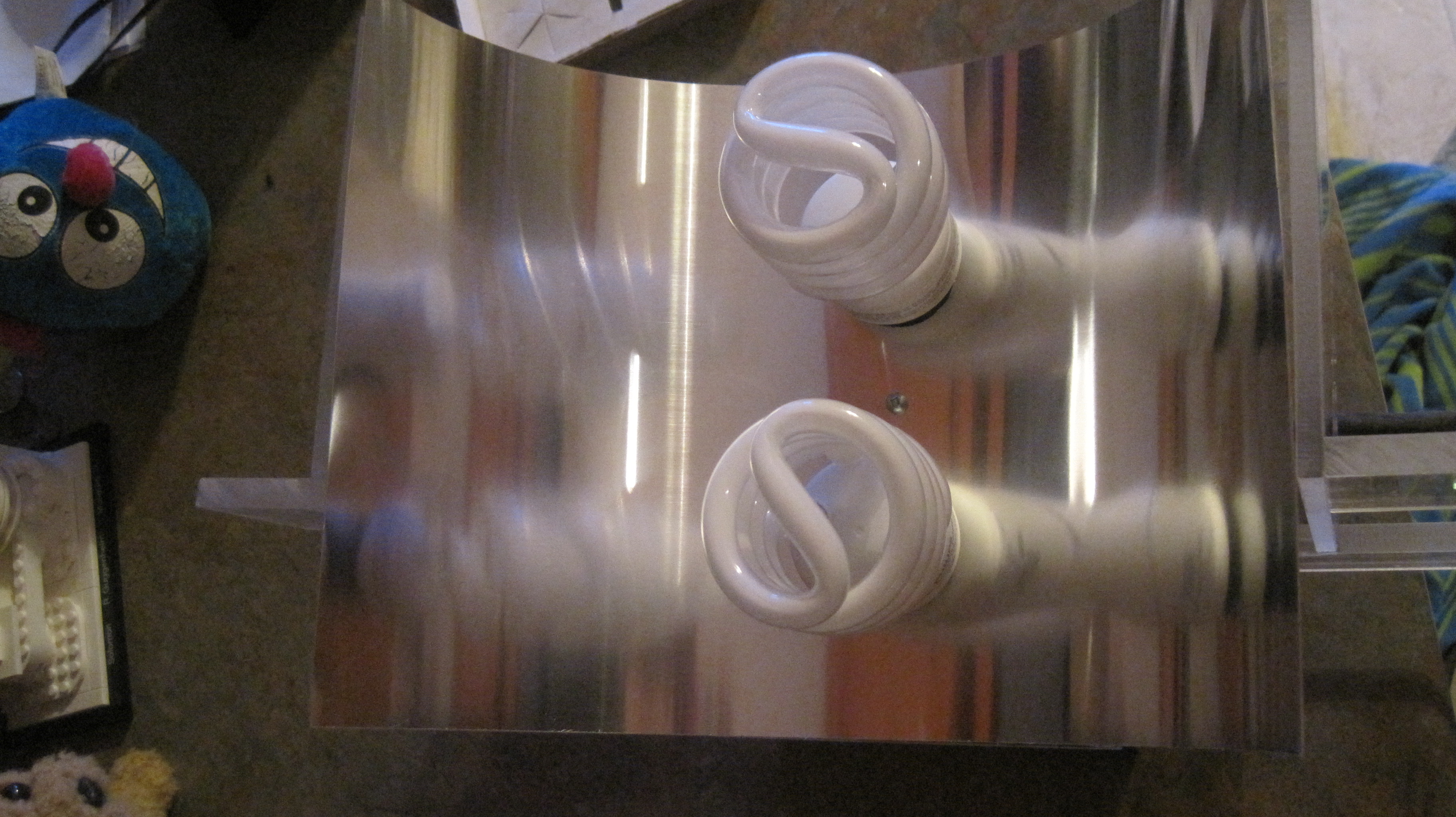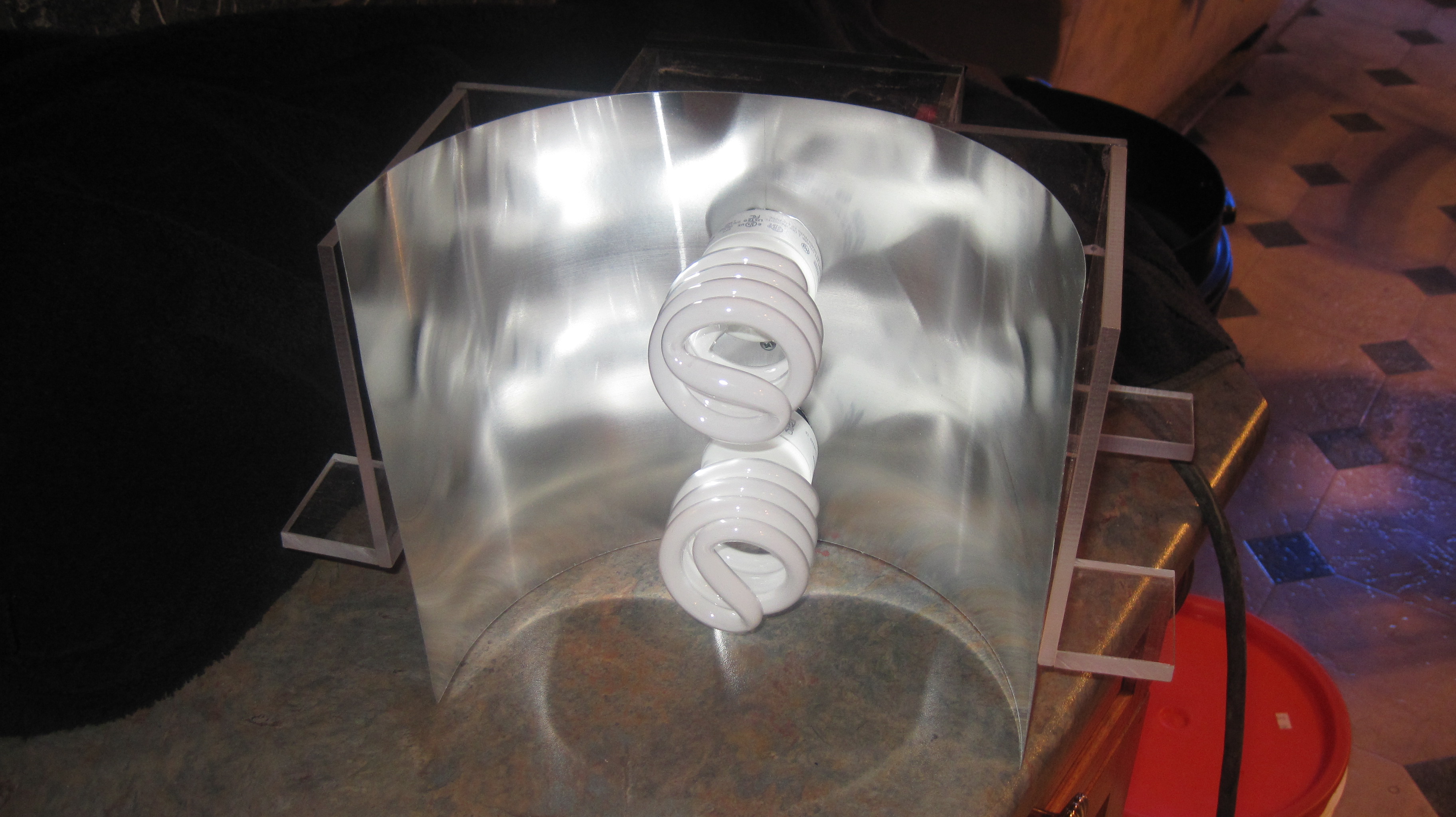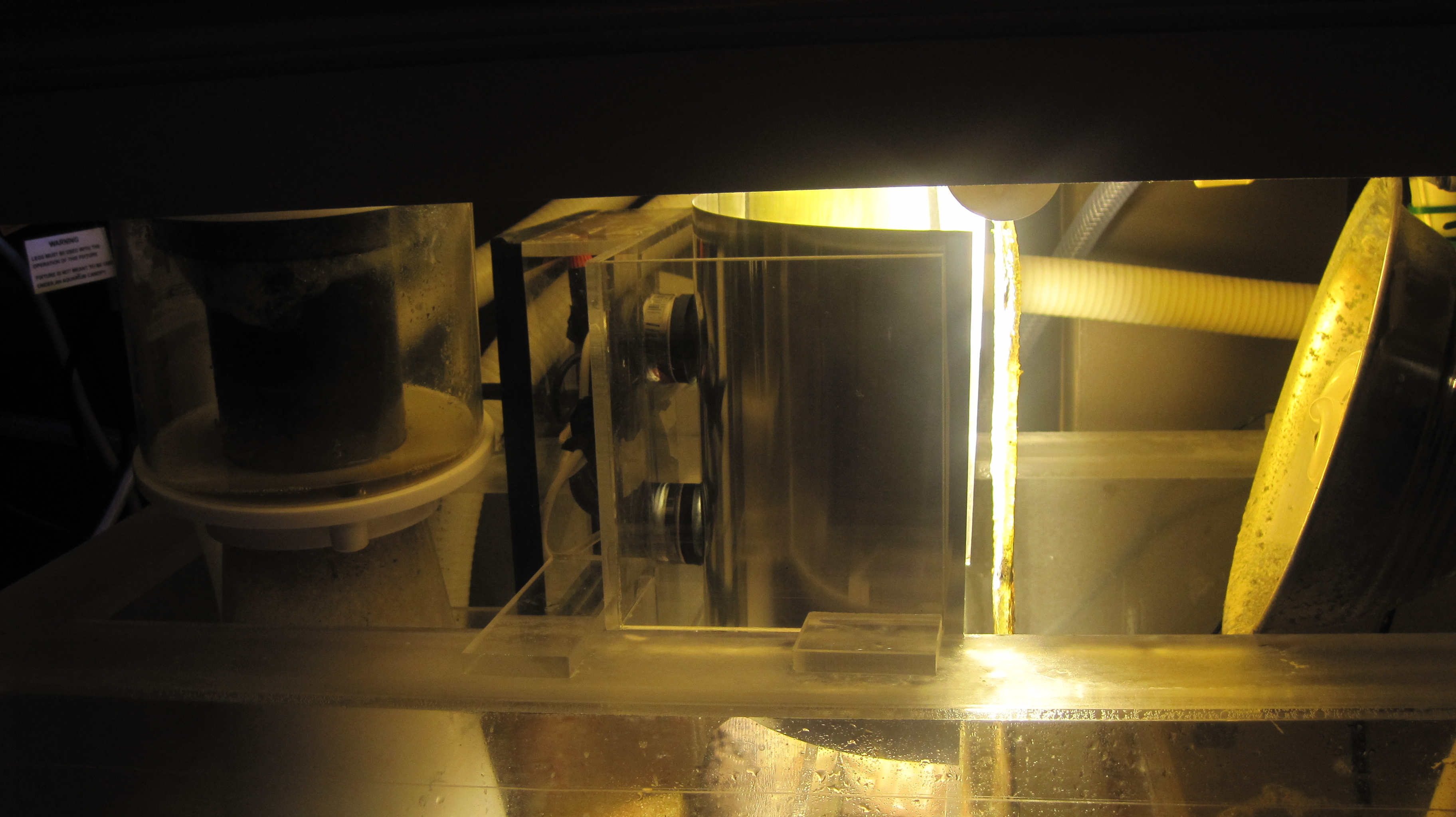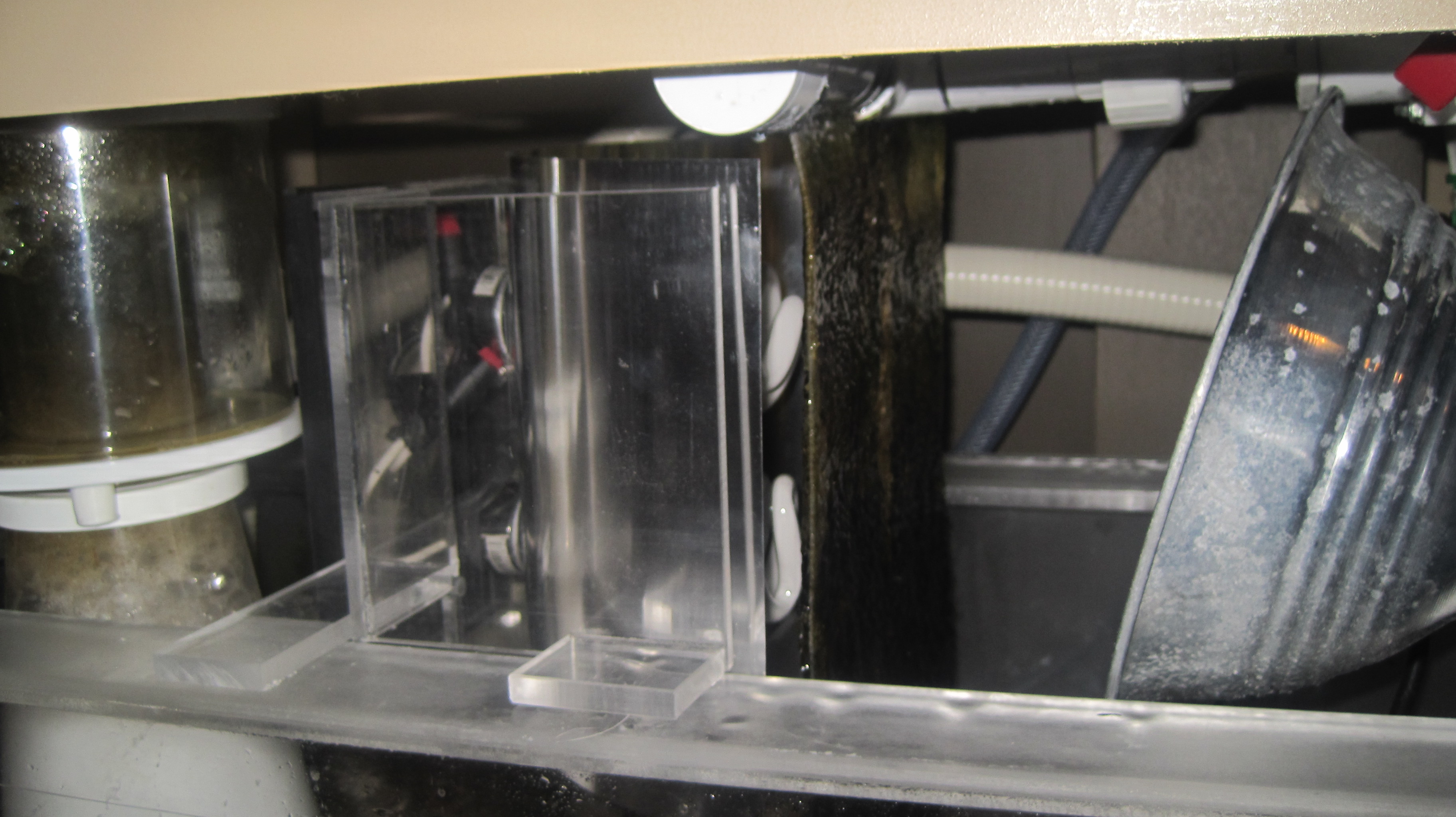Quote:
Originally Posted by
acrylic51 http:///t/386748/my-swc-160-protein-skimmer-is-not-working/80#post_3415284
Did a little more searching on scrubbers and came across an interesting thread a little older, but still interesting....Randy Holmes Farley suggests still a need to run GAC.....He states without it's use you will get "yellowing".....
Again guys a little slow and a lot of brain cells killed with WeldOn 40, but a skimmer and a scrubber remove the same nutrients, but???? And I know you already had mentioned this to me a bit ago Corey, but for this old slow guy??????
Snake is correct. A skimmer removes protiens and a scrubber removes actual nutrients. The reason for the yellowing water is dying algae. Which is why you need to clean it regularly so that you don't have die off on the bottom of the screen and a leaching of nutrient back into the water column. Once it gets thick the light can't penetrate. And yes, alot of people used to clean screens in tank water or dip the screen in their tank water and shake it to try and get the pods off of it. You don't want to do that. But if that ever did happen. The scrubber itself will remove the yellow coloring on it's own. I actually don't go to RC to do scrubber research anymore, reason being is there are too many manufacturers over that that post on the site who are anti scrubber. Which is why S.M. won't post over there. They bash him too much and try to discredit it's capabilities. But even so there are some folks running successful scrubbers over there.
"In my reading of what is going on lately with the discussions of skimmer vs. skimmerless tanks, I'm seeing the same fallacy repeated over and over and over, usually by the most experienced reefers who have been around the longest: "Because everyone uses skimmers, a skimmer must be required or else they wouldn't use one." Or, "Every Tank-Of-The-Month has a skimmer, therefore a skimmer is required to give you the best chance of a TOTM."
It's all completely irrelevant. I can't believe how many people fall for this line of reasoning. This trick is taught in Debate class in high school; It's called "Appeal to Poplulariy", otherwise known at Argumentum ad populum...
http://en.wikipedia.org/wiki/Argumentum_ad_populum " />
On a side note, realize that many people are paid to promote skimmers. Millions of dollars are put into the marketing and promotion of skimmers, and some of that money goes into the pockets of the people who are posting reasons to have skimmers. Also, there must be a hundred companies who make skimmers, and all of them have promotion budgets. The job of promotion is to "get the word out". How many Algae Scrubber companies have promotion budgets? Zero, because there are no companies. Scrubbers are DIY. This is why the "popular thinking" is to use a skimmer... because skimmers are all anyone reads about. Promotion is my day job, and this is exactly how it works."
And if your curious as to how scrubbers can actually improve water clarity, here ya go....
How Scrubbers Improve Water Clarity, or The Microbial Loop: Our Invisible Friend
This came to me after reading Wetzel's "
Limnology: Lake and River Ecosystems", which freshwater types may know of via Walstad's "Ecology of the Planted Aquarium"... But few hobbyists, freshwater or salt-, will ever be moved to buy, let alone read "Limnology", as it's a 1000 page college textbook. Yes, that's right: One. Thousand. Very. Dry. Pages. Happily, though, the last 150 or so are mostly the index and bibliography... Actually, I kid. I found the book to be very rewarding -- it completely overturned my understanding of freshwater aquatic ecology.
I put together Wetzel's emphasis that heterotrophic microbial detrivores, rather than autotrophs such as algae, are the backbone of freshwater ecosystems with a blurb I came across a while back in a science magazine that mentioned the discovery that in marine ecosystems, more than half of the dissolved organic carbon in the water is metabolized by "photoheterotrophic" bacteria. Between that factoid and Wetzel's observation that "up to 99% of organic matter fluxes in aquatic ecosystems are detrital-based" (...meaning that herbivorous and predatory relationships that pass energy up the food chain are trivial compared to the all the stuff that doesn't get eaten but instead passes its stored energy down to the detrivores when it dies) and that "processes are functionally similar in freshwater and marine ecosystems", I felt I had a basis for extrapolating from freshwater temperate lakes to saltwater tropical fish tanks... And then I did some reading on Wikipedia and learned that my flash of insight was apparently the subject of "
The Ocean's Food Web, A Changing Paradigm" by Larry Pomeroy, a
seminal marine biology paper published in 1974.
Here's the short version for those fluent in Science:
Scrubbers improve aquarium water clarity (which, as noted in the
FAQ, means removing discoloration or tinting, not cloudiness or particles suspended in the water) by, paradoxically, dumping dissolved organic carbon into the tank. Since DOC is what's discoloring the water in the first place, you'd think this would worsen the problem, not fix it, but the steady influx of lower molecular weight DOC fosters the growth of bacterioplankton, and they clear up the water by breaking down inedible medium weight DOC molecules with enzymes and consuming high molecular weight (from the hundreds of Daltons into the kD range) DOC compounds through a metabolic pathway facilitated by low molecular weight DOC. How this works is unclear, AFAIK, but bacterioplankton alone can't metabolize kD DOC; if provided with low molecular weight DOC, they can.
Further, a significant portion of the food value scrubbers provide comes from bacterioplankton, as
many useful chemicals produced by algae are exactly the sort of low molecular weight DOC that bacteria thrive on, and we know that even in a skimmed system, where the population of bacterioplankton is kept artificially low because skimmers preferentially remove particulate organic carbon, there are still enough around to make vodka dosing work. It's reasonable to conclude that a lot of the DOC coming off a scrubber is being metabolized by bacterioplankton... Indeed, I believe the reason scrubbers are so comprehensively effective is that they support a functioning
microbial loop -- a healthy population of heterotrophic bacterioplankton and protists that competes with nuisance algae for mineralized nitrogen and phosphorous in the water column, consumes DOC and detritus from egestion and uneaten food, and keeps these nutrients in circulation in a form that's available to zooplankton and other filter feeders in the aquarium. (...And, yes, I'm well aware that some bacteria and protists are autotrophs and contribute to primary production, but I'm trying to keep this as simple and as short as I can. For the same reason, I'm also avoiding the complexities of the microbial loop, the concepts of
eutrophy and oligotrophy, and reducing conditions in the substrate that affect nutrient solubility and concentration -- which, for those of you playing along at home, can be hundreds or eventhousands of times higher than the concentration measured in the overlying water!)
And here's the long version for those who'd like to know what the heck I'm talking about:
So, here's the thing... We tend to perceive autotrophs as being at the base of the food chain because plants seem to make something from nothing, and all us humans and the other heterotrophs we see around us depend on the plants, directly or indirectly, for our daily bread. It is nothing less than intuitively obvious to us that the base of the food chain must be the plants... But the real base of the food chain isn't the autotrophs, it's the heterotrophic microbial detrivores (bacteria, fungi, and single-celled organisms called protists) that consume dead organic matter and recycle the nutrients that the autotrophs require. This is why organic gardeners like to say that they don't grow vegetables; they grow good soil, and the veggies take care of themselves.
In aquatic ecosystems, some bacteria (including cyanobacteria, FYI) have adapted to living planktonically in the water and are known as bacterioplankton, though they can also colonize detritus and live in biofilms. In low-nutrient FW lakes with depths exceeding 10-20m, detrivorous bacterioplankton have been found to consume most (80-90% or more) of the organic material sinking out of the top layer of the lake before it reaches the anoxic or anaerobic zone below, where decomposition slows -- meaning the bacterioplankton keep these nutrients in circulation by eating the particulate organic carbon (like dead algae and zooplankton) as it slowly sinks into the depths of the lake, as well as the dissolved organic carbon compounds (like sugars and amino acids) that percolate out of dead and damaged cells. Similar results were found in SW during failed geoengineering experiments involving seeding the ocean with iron to induce phytoplankton blooms, absorb dissolved CO2 from the water, and hopefully identify a method of mitigating global warming. It was hoped that the phyto, once dead, would sink to the seafloor and sequester the carbon it had absorbed, but researchers found that very little organic carbon survived sinking through the upper layers of the ocean.
So what's the big deal about this "organic carbon" that I keep bringing up? Well, it's the medium through which most of the energy in any natural ecosystem is exchanged -- even autotrophs can absorb and metabolize dissolved organic carbon from their surroundings to some minimal degree (...if they didn't, allelopathic chemical warfare wouldn't work). Consider: the sugar in honey and maple syrup and fizzy drinks is dissolved organic carbon; the reason blueberries taste like blueberries and oranges taste like oranges is that they make different kinds of DOC, as well as the same kinds in different concentrations; vitamins are DOC; caffeine is DOC; antibiotics are DOC; venom is DOC; a steak is insoluble, so it's particulate organic carbon, but the amino acids that make up the proteins in the meat are soluble in water -- they were originally DOC before being assembled into proteins, and in some form or another they will be DOC again as the meat breaks down during digestion or decomposition. Organisms break down organic carbon compounds and extract energy from the chemical reactions involved, and they invest energy into organic carbon compounds to assemble chemicals they need to live, grow, and reproduce. Not to belittle the significance of ammonia and orthophosphate, but that's pretty much how life works here on scenic Earth.
This is counterintuitive to hobbyists accustomed to testing for and thinking in terms of mineralized (inorganic) nutrients and ions, particularly saltwater hobbyists who must monitor many additional parameters beyond N, P, and water temperature. ...But ultimately, it's nitrogen and phosphorous that are the enduring problems for most fishkeepers because they accumulate in our padding-top: 0px; padding-right: 2px; padding-bottom: 1px; padding-left: 2px; background-color: rgb(243, 191, 204); color: rgb(188, 42, 77); ">water and substrate and can lead to algae growth, dead livestock, and catastrophe. In nature, however, these elements are the two most common limiting nutrients in aquatic systems, meaning that one or the other (usually phosphorous) ends up being depleted and limiting further growth. Thus, in P-limited systems, N can accumulate; in N-limited systems, P can accumulate; if N and P are both accumulating, then the limiting nutrient must be something else. For autotrophic phytoplankton and other algae, that limiting nutrient is most likely to be iron or some other familiar micronutrient, but for heterotrophic bacterioplankton, it turns out to be dissolved organic carbon -- which is why vodka dosing works... It takes several atoms of carbon for an organism to integrate a single atom of nitrogen into itself as it grows, and lots more C than that for a single atom of phosphorous -- marine plankton sampled by dragging a fine-mesh net through the water, for example, have roughly the same collective average ratio of C:N

worldwide ("the Redfield ratio"): 106:16:1 or 41:7.2:1 by weight. Autotrophs normally derive the carbon they need from CO2, which means they're responsible for bringing carbon into the system, incorporating it into organic molecules, and building up the total biomass of an ecosystem (this is called "primary production"), while heterotrophs obtain C by consuming organic carbon molecules, like the ethanol in vodka or the acetic acid in vinegar, and ultimately convert organic carbon back to CO2.
Dissolved organic carbon dominates the biological activity of natural aquatic ecosystems, if for no other reason than because particulate organic carbon tends to sink to the bottom, where it decays much more slowly due to low temperatures and the anoxic or anaerobic environment, and it could even end up getting buried and taken out of circulation entirely. DOC molecules come in small, medium, and large sizes. Small molecules can be absorbed and metabolized very quickly by a wide variety of organisms, and they tend to be the richest of the lot in energy (like sugar and other carbohydrates) and/or nutrition (such as amino acids, which can have a C:N ratio as low as 2:1). Heterotrophic bacteria compete aggressively for this important food resource -- also why vodka dosing works, BTW.
Larger DOC molecules, however, have to be broken down into bite-sized chunks to be made useful. Bacteria use enzymes to do this, but as the target molecules grow larger and larger, they tend to become less and less vulnerable to bacterial enzymes. The fraction of DOC that isn't vulnerable, or is only marginally vulnerable, to these enzymes is termed "recalcitrant" because it's slow to break down and be recycled into the food web (...it bears mentioning that fungi have a different arsenal of enzymes and can make a living off of recalcitrant organic carbon, but they prefer particulate detritus). About 95% of the DOC in the oceans is recalcitrant -- not because there's so much of it around, but because the non-recalcitrant fraction gets eaten so quickly. Bacterioplankton can degrade and metabolize large DOC molecules when they have access to a steady supply of small DOC compounds, but absent these nutrients, recalcitrant molecules are pretty much only vulnerable to being broken down by light, a process called "photolysis". In principle, photolysis alone can break down even the largest organic carbon molecules all the way to CO2, but it takes a long time, so recalcitrant DOC tends to accumulate in the water column.
Though these recalcitrant DOC molecules were thought to be all but biologically inert by early researchers, it turns out they're crucial to ecological stability because they provide a reserve of dissolved nutrients -- not just carbon, as the phrase "dissolved organic carbon" would imply, but these large, complex molecules also carry tiny amounts of nitrogen, phosphorous, sulfur, and other crucial nutrients -- that slowly breaks down into edible molecules when struck by light. This trickle of food is enough to sustain a functioning microbial ecosystem in the open water during times of scarcity, preventing a catastrophic crash and loss of biodiversity among the bacterioplankton. And because the detrivores recycle nutrients, their survival means the diatoms and phyto will live to bloom another day, as well.
And what does all this have to do with algae scrubbers? For one thing, algae, like any other organism, releases DOC compounds in the normal course of its life cycle. For another, scrubbers are home to pods, which can't fully digest everything in the algae they eat and thus excrete a lot of organic molecules, some of them degraded to a greater or lesser degree, and some (generally the larger, more recalcitrant ones) all but untouched. And pods are messy eaters -- maybe 10-15% of the DOC in the algae being eaten is lost into the water column when the cells are ruptured (and possibly more than that, given the high flow on an ATS). Further, routine maintenance includes a weekly cleaning, which means that when the filter is reinstalled, it's covered with a host of dead and dying baby pods and algal cells. And, of course, in any large population of living creatures, whether it's a colony of algae or a city of human beings, a certain number of them are dying of natural causes at any given moment, and each one spills forth a complex broth of organic molecules of all sorts and sizes as they decay.
With all that DOC diffusing into the water column, having a scrubber is like drip-feeding your tank vodka -- no, wait... I take that back... Because of the diverse array of small, medium, and large DOC compounds involved, it's vastly better than drip-feeding your tank vodka.
Dosing a saltwater tank with alcohol (or vinegar, or some other source of off-the-shelf, low molecular weight dissolved organic carbon) is a pale imitation of the buffet of DOC available in the ocean, yet even so, it's sufficient to trigger a wave of bacterial growth that is then skimmed off. Given access to DOC, bacterioplankton will grow and reproduce very quickly by absorbing mineralized N and P from the water -- which is probably the "why" behind the empirical knowledge recorded in the scrubber FAQ that it's best to keep a skimmer running for a few weeks after setting up an algae scrubber, even when you're getting lush, dark, crazy fast algae growth in a high-nutrient situation: the skimmer is exporting an unseen bloom of bacterioplankton while the scrubber exports the autotrophs that get all the glory.
Now, to be clear, I'm not disputing that the algae is where the action is. Bacterioplankton do NOT export nutrients, metals, or anything at all... unless you skim them off, but in a mature system, skimming doesn't so much turbocharge your nutrient export capacity as it hobbles the natural waste reclamation and food manufacturing system you're tapping into with an algae scrubber. Bacterioplankton do NOT efficiently sequester nutrients by passing them up to a higher trophic level... less than 10% of the energy in any level passes up to the next, such as from plants to herbivores or prey to predator, and there's some evidence to suggest that the coupling between the microbial detrivores and the animals that eat them is the least efficient of all (but that said, filter feeders can really do a number on plankton). Bacterioplankton is NOT the secret weapon that makes scrubbers work... but bacterioplankton do help scrubbers work better, as evidenced by the (heretofore mysterious) ability of scrubbers to improve water clarity: photolysis alone can't clear up the water, but photolysis along with bacterial enzymes and co-metabolism of large and small DOC molecules can.
In sum, installing a scrubber and removing the skimmer shifts a SW aquarium from a state in which algae have a huge competitive advantage (because they can metabolize the mineralized nitrogen and phosphorous that's accumulating in the system) to one in which bacterioplankton compete effectively for N and P (because DOC is a vast pool of nutrients that autotrophs are all but locked out of) -- and this, it turns out, is as it should be. Such a state is a closer approximation of NSW because it fosters the bacteria known to process most of the dead organic matter in the world's oceans instead of removing them with a skimmer. And because production and biodiversity is being supported at the very bottom of the food chain, where it really counts, it probably also is a state in which an aquarium is less likely to crash.
--
BONUS THEORY: If you've read this far, you deserve a reward! Here's another notion for the interminably curious and the incurably sleepless to chew on...
Another reason that livestock responds so positively to algae scrubbers is that the DOC they release can transport micronutrients by a process called "complexation" (...not to be confused with "chelation"). You've seen nutrients, maybe even in supplements you take every morning, yourself, described as "iron complex" or whatever, yes? All this means is that the iron is being carried around bound to... you guessed it... dissolved organic carbon. In other words, DOC isn't just good for bacterioplankton and zooxanthellic symbionts because they have a taste for it -- it can also bring along iron and manganese, which normally aren't free to move around much in oxygenated water, as well as other micronutrients whose solubility isn't governed so strongly by redox conditions, like molybdenum, copper, and zinc.
So an algae scrubber isn't a "twofer" because it grows bacterioplankton as well as algae... It's a "threefer" because DOC can also facilitate the movement of metallic micronutrients. Yowza!!!
--
ALSO WORTH THINKING ABOUT: Cyanobacteria release a lot of high molecular weight DOC. Since these are energy-intensive compounds to manufacture, that's interesting behavior and must be in some way adaptive... The function of most of these compounds seems to be about managing cyano's microenvironment (for example, cyano in FW is known to evade copper-based herbicides by secreting a polypeptide that adsorbs copper), but it's possible that others are part of cyano's extensive chemical warfare arsenal -- that is to say, they're allelopathic. If so, facilitating their destruction, and presumably the destruction of allelopathic DOC molecules in general, by bacterioplankton may be another valuable service indirectly provided by an algae scrubber.
--
AND ONE OTHER THING: I'm curious as to whether there are anecdotal reports of scrubbers improving water clarity in freshwater systems. I've been playing with a FW blackwater tank (DSB with no filtration and no scrubber -- LMW DOC input comes from floating plants, excreta, and homemade fish food) because the tannins discoloring the right: 2px; padding-bottom: 1px; padding-left: 2px; background-color: rgb(243, 191, 204); color: rgb(188, 42, 77); ">water are recalcitrant DOC. When I adjusted the mechanics to minimize flow and induce low-level anoxia at the bottom of the tank, the water darkened; when I returned circulation and properly oxygenated the entire water column, water clarity improved. As the lighting regime, resident population, and other obvious variables in this tank were left unchanged, I believe the change in water clarity can be ascribed to the activity, and likely also the population, of bacterioplankton damping down and ramping up (...though on the other hand, it could also be the result of activity among the epiphytic community -- that is, the biofilms that grow on plants). When oxygen and low molecular weight DOC are available, bacteria are able to consume the recalcitrant tannins at a high enough rate to improve water clarity; when these nutrients are not being circulated effectively, consumption of recalcitrant DOC is reduced or prevented and water clarity suffers as tannins accumulate.
It must be noted, however, that I seeded the water in this tank at the time of its setup with a gallon or two of water from a pond water culture tank I also maintain... FW hobbyists in general do not do this sort of thing, while seeding SW systems with an array of inverts and microorganisms is pretty much SOP. Given that the fauna and flora (excepting the higher plants) in fresh water are, to begin with, stunted versions of the highly diverse populations found in saltwater -- that is, the pods, algae, fish, etc. in FW are all descended from a comparative handful of pioneering species that evolved in the oceans and adapted to life in rivers and lakes -- it's possible that the average FW hobbyist lacks a diverse population of bacterioplankton and thus will not fully benefit from tapping into the microbial loop. That a freshwater scrubber will export nutrients and suppress nuisance algae, however, appears to me to have been adequately demonstrated, and since that's what most people are interested in, this possibility should not deter FW hobbyists from trying algae scrubbers.






